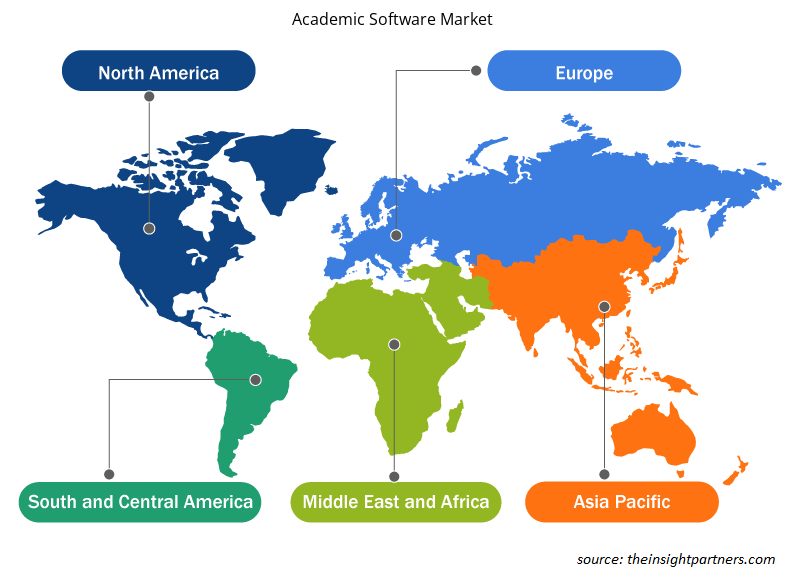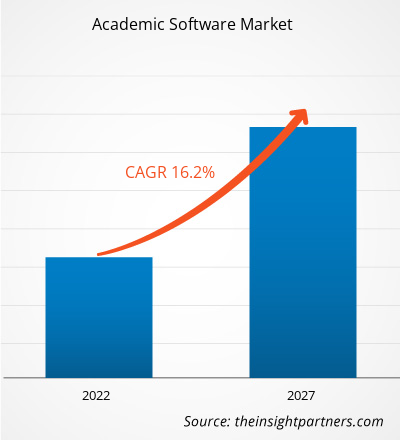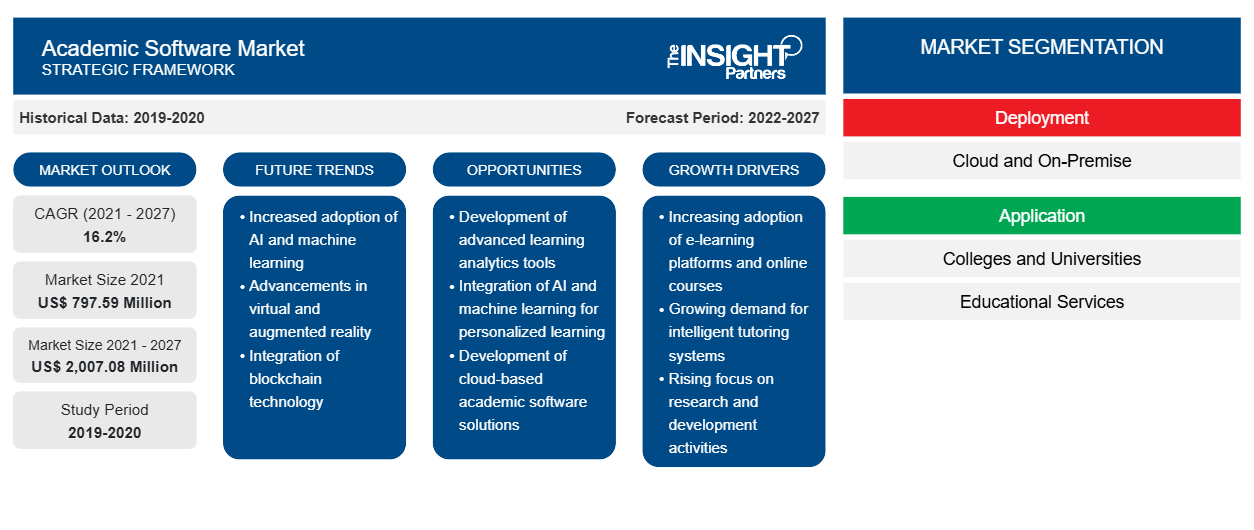학술 소프트웨어 시장은 2021년 7억 9,759만 달러에서 2027년 2,007.08만 달러로 성장할 것으로 예상됩니다. 학술 소프트웨어 시장은 2021년부터 2027년까지의 예측 기간 동안 16.2%의 CAGR로 성장할 것으로 예상됩니다.
기관 전체에서 e러닝을 채택하는 것이 학술 소프트웨어 시장 성장을 이끄는 핵심 요인입니다. e러닝에서 콘텐츠를 읽거나 시청함으로써 교육이 제공되는 방식이 변화하고 있습니다. 애니메이션, 팟캐스트, 비디오와 같은 여러 e러닝 과정은 다중 모드의 현실적인 학습 환경을 만듭니다. e러닝, 교육 콘텐츠는 컴퓨터, 랩톱, 태블릿 또는 스마트폰을 통해 학습자에게 여러 가지 몰입형 학습 기회를 제공합니다. 학생들은 수동적인 환경에 있는 대신 쉽고 빠르게 학습할 내용을 선택할 수 있습니다. 이러한 이점은 전 세계적으로 학술 소프트웨어에 대한 수요를 증가시키고 있습니다.
COVID-19 팬데믹은 전 세계 교육 부문에 심각한 영향을 미쳤습니다. 이는 또한 전 세계 모든 주요 경제권에서 온라인 교육 시스템 도입을 촉진했으며, 이를 통해 강의 제공, 학생 관리 및 원격 위치에서의 기타 운영 활동과 같은 다양한 응용 프로그램을 위한 소프트웨어 도입에 영향을 미쳤습니다. 따라서 이 부문 전체에서 기술적으로 진보된 솔루션의 도입이 증가함에 따라 팬데믹 동안 학술 소프트웨어 시장 의 성장에 긍정적인 영향을 미칠 것으로 예상됩니다.
배포를 기준으로 학술 소프트웨어 시장은 클라우드와 온프레미스로 구분됩니다. 2019년에는 클라우드 세그먼트가 시장에서 더 높은 점유율을 차지했습니다. 최근 몇 년 동안 기술 산업은 클라우드 기반 컴퓨팅 채택이 꾸준히 크게 증가했습니다. 이는 클라우드 기반 컴퓨팅이 구현 시간을 간소화하고 배포 비용을 크게 절감하기 때문입니다. 이러한 이점은 많은 최종 사용자를 유치했으며, 따라서 대부분의 학술 소프트웨어 시장 참여자는 클라우드 기반 소프트웨어에 대한 수요 증가와 함께 클라우드 기반 제품을 제공합니다. 또한 선진국의 인터넷 인프라가 발전하여 많은 개발도상국에서 번성하고 있어 최종 사용자가 선진국과 개발도상국 모두에서 클라우드 기반 솔루션에 액세스할 수 있습니다.
귀하의 요구 사항에 맞게 이 보고서를 사용자 정의하세요
이 보고서의 일부 또는 국가 수준 분석, Excel 데이터 팩을 포함하여 모든 보고서에 대한 사용자 정의를 무료로 받을 수 있으며 신생 기업 및 대학을 위한 훌륭한 혜택과 할인 혜택을 이용할 수 있습니다.
- 이 보고서의 주요 시장 동향을 알아보세요.이 무료 샘플에는 시장 동향부터 추정 및 예측까지 다양한 데이터 분석이 포함됩니다.
학술 소프트웨어 시장 통찰력
인공지능 등의 기술과 학술 소프트웨어 솔루션의 통합
인공 지능(AI)은 컴퓨터가 사람과 같은 방식으로 사람과 소통하고, 사건을 이해하고, 사건에 대해 학습하고 반응할 수 있는 능력을 부여하는 기술입니다. 수년에 걸쳐 인공 지능은 보안, 감시 및 정보 기술과 같은 산업 전반에 걸쳐 엄청난 응용 프로그램을 가졌을 뿐만 아니라 교육 부문에서 이 기술의 도입이 증가했습니다. AI는 성적 평가, 재무 분석 및 입학 절차와 같은 반복적인 작업을 자동화하기 위해 학교, 단과대학 및 대학에서 도입되고 있습니다. 예를 들어, AI는 고급 컴퓨터 프로그램(예: Automated Grading)을 통해 성적을 매기는 동안 교사의 행동을 학습하고 모델링하도록 교정하여 미래에 자동 성적 할당을 할 수 있습니다. 시간이 지남에 따라 프로그램은 여러 학생의 학업 기술을 학습하고, 그들의 성과에 따라 맞춤형 교육 계획을 준비합니다.
배포 기반 시장 통찰력
배포 유형에 따라 글로벌 학술 소프트웨어 시장은 클라우드와 온프레미스로 구분됩니다. 클라우드 기반 학술 소프트웨어는 온프레미스 학술 소프트웨어에 비해 수요가 높습니다. 클라우드 세그먼트는 선진국의 강력한 네트워크 인프라로 인해 비교적 비용이 적게 들기 때문에 대부분의 수요를 창출합니다. 또한 클라우드 기반 학술 소프트웨어 공급업체는 사이버 공격의 위험을 제거하기 위해 고급 보안 패치를 개발하는 데 중점을 두고 있습니다. 이러한 요인은 최종 사용자로부터 상당한 수요를 창출하여 학술 소프트웨어 시장을 주도하고 있습니다.
애플리케이션 기반 시장 통찰력
응용 프로그램을 기준으로, 학술 소프트웨어 시장은 단과대학 및 대학, 교육 서비스 및 기타로 세분화됩니다. 교육 기관 및 대학에서 학생들에게 온라인 및 오프라인 과정을 제공하기 위해 현대 솔루션을 점점 더 많이 도입하고, 모든 직원과 학생에게 고급 솔루션을 제공하려는 이니셔티브가 학술 소프트웨어 도입에 영향을 미치고 있습니다. 이는 수년에 걸쳐 시장 성장을 촉진하고 있습니다.
학술 소프트웨어 시장에서 활동하는 업체들은 학술 소프트웨어 시장에서의 입지를 유지하기 위해 시장 이니셔티브, 인수, 제품 출시와 같은 전략에 집중합니다. 학술 소프트웨어 시장의 주요 업체들이 이룬 몇 가지 발전은 다음과 같습니다.
2020년 12월, Alma 학생 정보 시스템 플랫폼은 성적부 도구에 추가된 학점 평균(GPA) 기능을 도입했습니다. 표준 기반 채점(SBG)은 여러 주제나 표준을 포괄하는 단일 점수를 사용하는 대신, 학생 피드백과 진도 측정을 가르치고 평가하는 특정 기술에 맞춰 조정하는 데 기반을 두고 있습니다.
2020년 7월, ConexED는 사용자 친화적인 경험을 위해 iOS 앱 2.2.3을 업데이트했습니다. 이 앱을 사용하면 학생, 직원, 교수진이 모바일 기기에서 가상 회의 및 화상 회의에 참여할 수 있습니다.
학술 소프트웨어 시장 지역 통찰력
Insight Partners의 분석가들은 예측 기간 동안 학술 소프트웨어 시장에 영향을 미치는 지역적 추세와 요인을 철저히 설명했습니다. 이 섹션에서는 북미, 유럽, 아시아 태평양, 중동 및 아프리카, 남미 및 중미의 학술 소프트웨어 시장 세그먼트와 지리에 대해서도 설명합니다.

- 학술 소프트웨어 시장에 대한 지역별 데이터 얻기
학술 소프트웨어 시장 보고서 범위
| 보고서 속성 | 세부 |
|---|---|
| 2021년 시장 규모 | 7억 9,759만 달러 |
| 2027년까지 시장 규모 | 2,007.08백만 달러 |
| 글로벌 CAGR (2021-2027) | 16.2% |
| 역사적 데이터 | 2019-2020 |
| 예측 기간 | 2022-2027 |
| 다루는 세그먼트 | 배치에 의해
|
| 포함된 지역 및 국가 | 북아메리카
|
| 시장 선도 기업 및 주요 회사 프로필 |
|
학술 소프트웨어 시장 참여자 밀도: 비즈니스 역학에 미치는 영향 이해
학술 소프트웨어 시장 시장은 소비자 선호도의 변화, 기술 발전, 제품의 이점에 대한 인식 증가와 같은 요인으로 인해 최종 사용자 수요가 증가함에 따라 빠르게 성장하고 있습니다. 수요가 증가함에 따라 기업은 제품을 확장하고, 소비자의 요구를 충족하기 위해 혁신하고, 새로운 트렌드를 활용하여 시장 성장을 더욱 촉진하고 있습니다.
시장 참여자 밀도는 특정 시장이나 산업 내에서 운영되는 회사나 기업의 분포를 말합니다. 주어진 시장 공간에 얼마나 많은 경쟁자(시장 참여자)가 존재하는지 그 규모나 총 시장 가치에 비해 나타냅니다.
학술 소프트웨어 시장에서 운영되는 주요 회사는 다음과 같습니다.
- 알마
- 캠퍼스 카페 소프트웨어
- 코넥스ED
- 엔비시오 솔루션 주식회사
- 풀패브릭
면책 조항 : 위에 나열된 회사는 어떤 특별한 순서에 따라 순위가 매겨지지 않았습니다.

- 학술 소프트웨어 시장의 주요 기업 개요를 알아보세요
학술 소프트웨어 시장 – 배포별
- 구름
- 온프레미스
학술 소프트웨어 시장 – 응용 프로그램별
- 대학 및 대학교
- 교육 서비스
- 기타
학술 소프트웨어 시장 – 지리별
북아메리카
- 우리를
- 캐나다
- 멕시코
유럽
- 프랑스
- 독일
- 러시아 제국
- 영국
- 이탈리아
- 유럽의 나머지 지역
아시아 태평양(APAC)
- 중국
- 인도
- 일본
- 호주
- 대한민국
- APAC의 나머지 지역
중동
- 사우디 아라비아
- 아랍에미리트
- 남아프리카 공화국
- MEA의 나머지
샘
- 브라질
- 아르헨티나
- SAM의 나머지
학술 소프트웨어 시장 – 회사 프로필
- 알마
- 캠퍼스 카페 소프트웨어
- 코넥스ED
- 엔비시오 솔루션 주식회사
- 풀패브릭
- 파워비스타 소프트웨어 주식회사
- 퀄트릭스 유한회사
- 토파트모노클 주식회사
- 트루다이얼로그
- 와이즈하이브
- 과거 분석(2년), 기준 연도, CAGR을 포함한 예측(7년)
- PEST 및 SWOT 분석
- 시장 규모 가치/거래량 - 글로벌, 지역, 국가
- 산업 및 경쟁 환경
- Excel 데이터세트
최근 보고서
관련 보고서
사용 후기
구매 이유
- 정보에 기반한 의사 결정
- 시장 역학 이해
- 경쟁 분석
- 고객 인사이트
- 시장 예측
- 위험 완화
- 전략 기획
- 투자 타당성 분석
- 신흥 시장 파악
- 마케팅 전략 강화
- 운영 효율성 향상
- 규제 동향에 발맞춰 대응





















 무료 샘플 받기 - 학술 소프트웨어 시장
무료 샘플 받기 - 학술 소프트웨어 시장